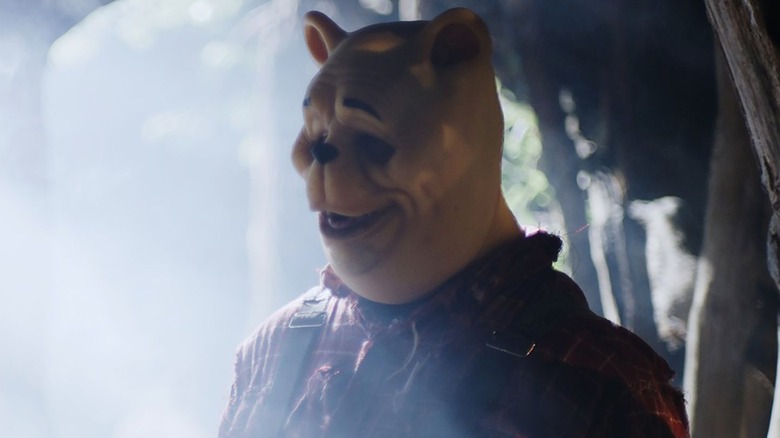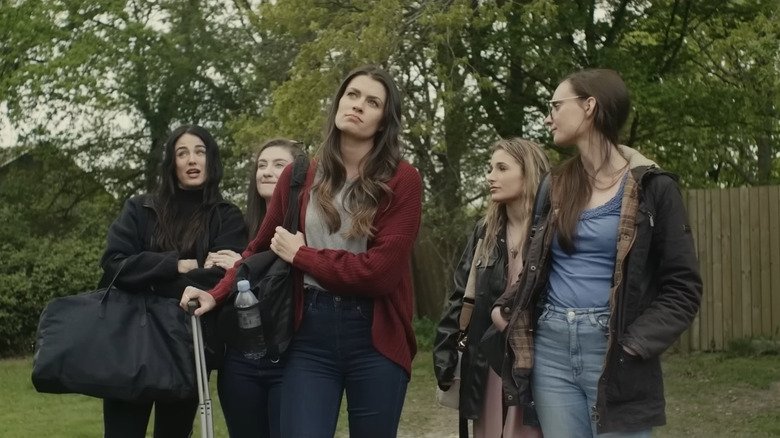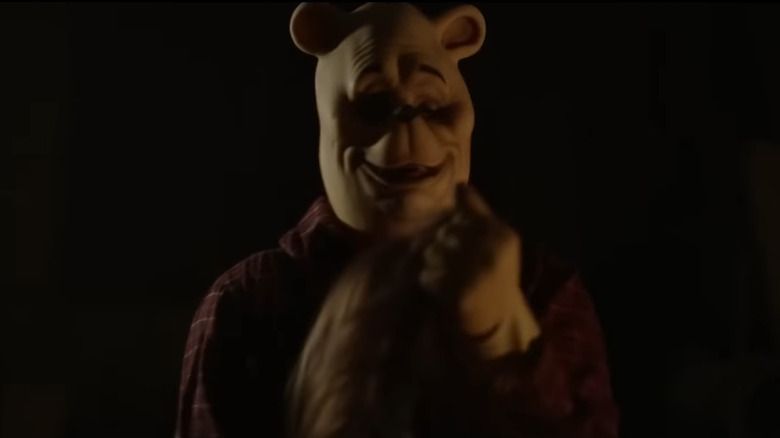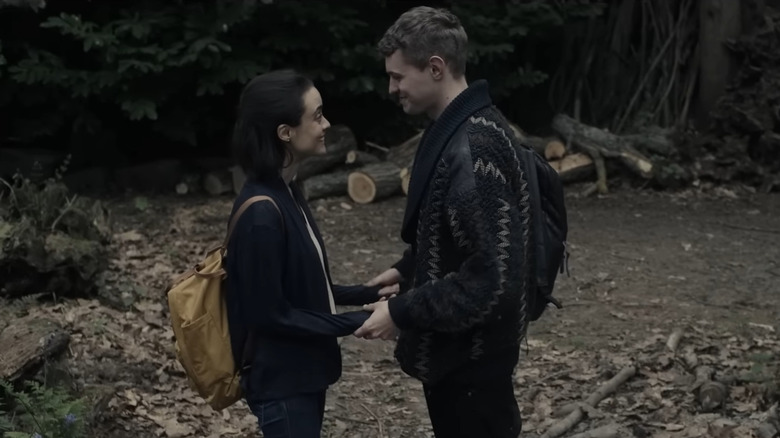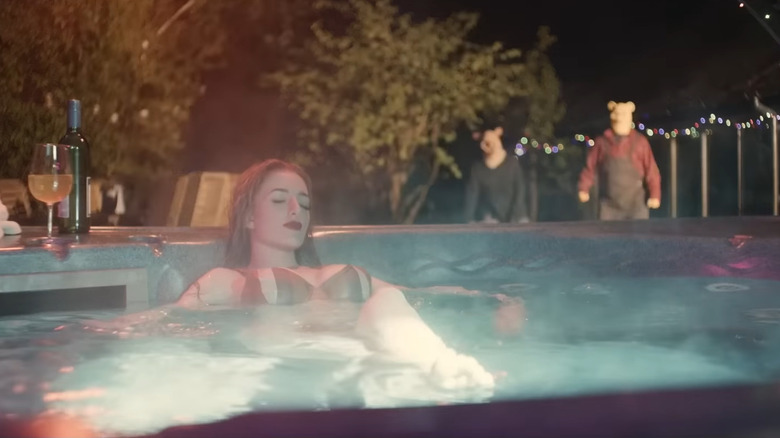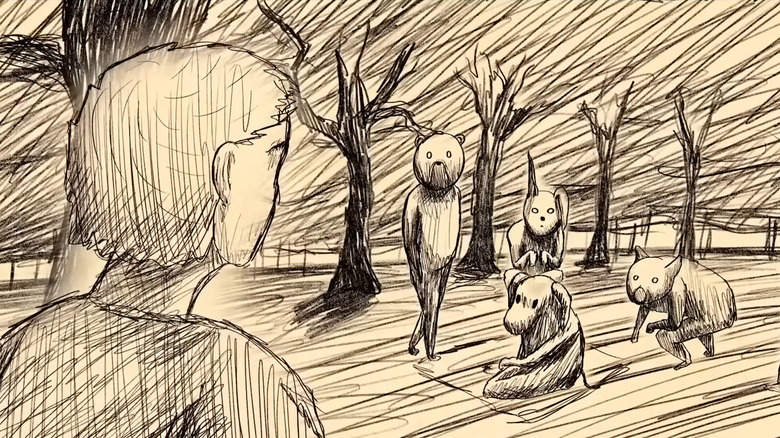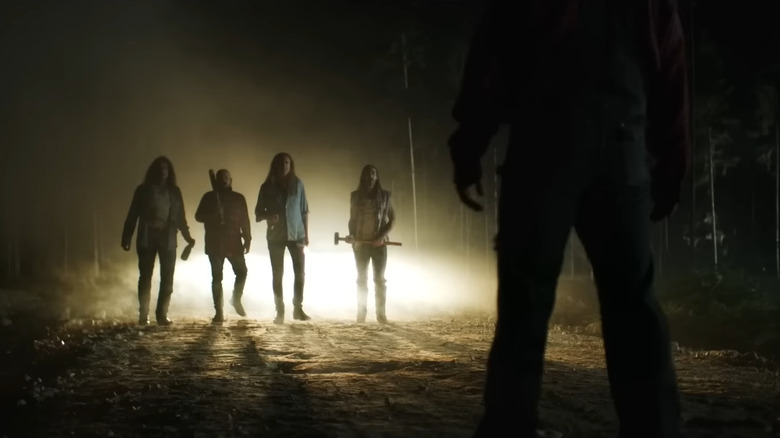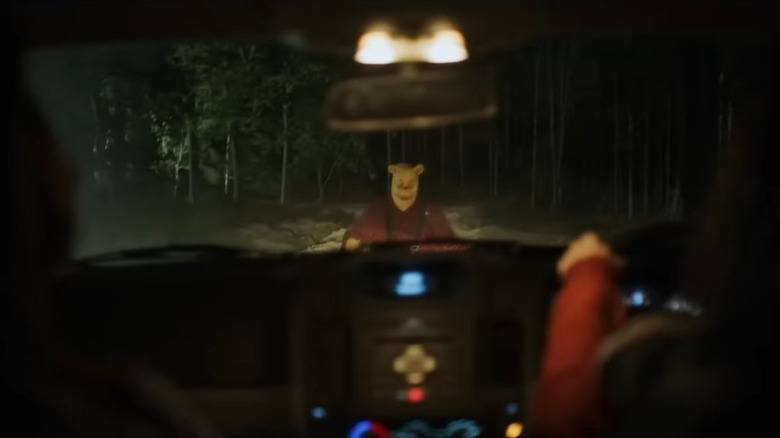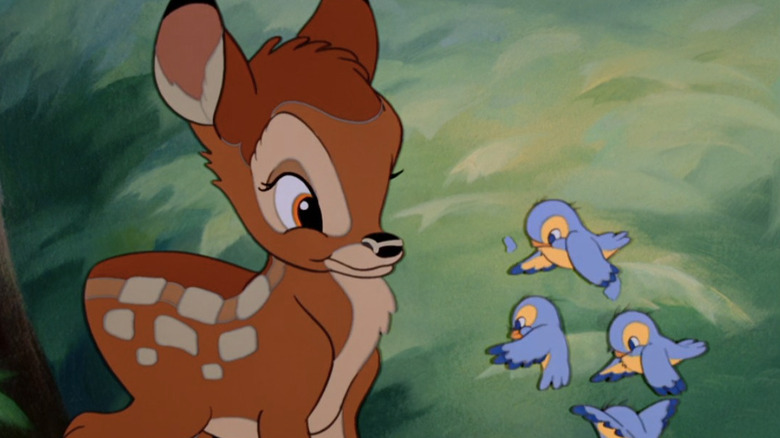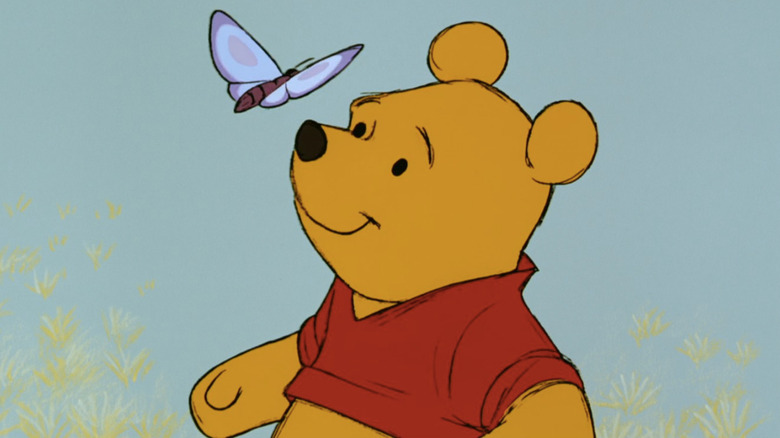Winnie-The-Pooh: Blood And Honey Ending Explained
In the blissful infancy of YouTube back in 2006, one of the medium's earliest viral sensations was a video called "Scary Mary." YouTube creator Christopher Rule edited his own trailer for "Mary Poppins," Disney's 1964 musical classic. Instead of depicting the movie's family-friendly fantasy, though, Rule cut "Scary Mary" as a horror film. The result was surprisingly convincing, and posited an intriguing, funny, and somewhat disturbing thesis: With a change in perspective, beloved fictional characters can instantly switch from kind to creepy.
The team behind "Winnie-the-Pooh: Blood and Honey" — a real movie in the Year of Our Lord, 2023 — embraced this spirit to imagine the universally adored Pooh Bear of literature and film as a serial killer. The film's violent conclusion leaves its story open-ended, and its filmmakers are just getting started building a children's-character-turned-slasher cinematic universe straight out of a fever dream.
And thus, I find myself for the third time this year being paid to analyze a movie that invites analysis about as much as a local car commercial does. That is to say, it doesn't. "Winnie-the-Pooh: Blood and Honey" is in no way a multifaceted story with layers of thought-provoking social commentary to extrapolate. As we'll discover, even its director approached the movie at its surface level. But we're /Film, this is what we do, and such discussion is partly why we all love movies so much in the first place. With spoilers abounding, this is the "Winnie-the-Pooh: Blood and Honey" ending explained. Oh, bother.
What you need to remember about the plot of Winnie-the-Pooh: Blood and Honey
Where to even begin? Years after spending his carefree youth with his cuddly animal companions, Christopher Robin (Nikolai Leon), now an adult, returns to the Hundred Acre Wood. He's there to introduce his wife Mary (Paula Coiz) to Pooh (Craig David Dowsett), Piglet (Chris Cordell), and the rest of the gang. (Probably not what Mary had in mind when her husband said he wanted her to meet his childhood friends. That's a red flag, ma'am.)
Rather than a warm welcome back, though, Christopher Robin finds his pals have gone feral, filled with rage after the boy abandoned them to grow up. Pooh and Piglet — appearing as grotesque, full-size creatures performed by actors in rubber masks — kill Mary and kidnap Christopher Robin.
Shortly thereafter, friends Maria (Maria Taylor), Jessica (Natasha Rose Mills), Alice (Amber Doig-Thorne), Zoe (Danielle Ronald), Lara (Natasha Tosini), and Tina (May Kelly) embark on a celebratory weekend getaway to a rental house in the woods. You can probably guess which woods. It's not long before Pooh and Piglet descend their wrath upon the house and everyone in it.
What happened at the end of Winnie-the-Pooh: Blood and Honey?
The entire third act of "Winnie-the-Pooh: Blood and Honey" essentially amounts to a killing spree. Pooh and Piglet torture and subsequently murder each occupant of the rental home one by one. Pooh wedges a knife directly into Alice's mouth until it protrudes out of the back of her neck. Piglet beheads Zoe with a sledgehammer. In one of the most brutally graphic moments of the film, the bear and swine run over Lara's skull with a car, and the audience sees every detail.
In the film's final moments, Maria and Jessica are the only remaining survivors of the group. Pooh is still on the hunt following the death of Piglet amidst the attacks. Maria and Jessica put up a good fight; the audience might wonder if the women will be triumphant over the not-so-silly old bear. Alas, such an outcome is too optimistic for this tale. Even as Christopher Robin escapes Pooh's torture room and comes to Maria and Jessica's aid, the women still perish by Pooh's hand.
Following a pensive moment and Pooh's only line of dialogue in the entire movie — "You left!" — Pooh lets Christopher Robin go free. The film ends somewhat abruptly given the heightened build-up of the story.
A new spin on the live-action remake trend
We're living in the age of live-action re-imaginings of familiar animated movies, and the ending of "Blood and Honey" presents a macabre take on this trend. For copyright purposes, "Blood and Honey" specifically draws on the original literature versions of the characters, as written by A.A. Milne, rather than the various Pooh films and television series produced by Disney.
Still, "Blood and Honey" shares similarities with a number of Disney-driven stories in its inciting incident. The idea of Christopher Robin disappearing from the Hundred Acre Wood is one we've seen before, first in 1997's "Pooh's Grand Adventure: The Search for Christopher Robin" and again in 2011's (criminally underrated) "Winnie the Pooh." In both cases, the boy is merely away at school and returns shortly, still a child and ready for more playtime. In 2018's live-action "Christopher Robin," also made by Disney, the titular character similarly leaves, but returns as a business-minded adult portrayed by Ewan McGregor in need of being reminded of his childhood, a la Robin Williams in "Hook."
"Blood and Honey" is ... not that. From live-action Disney films that re-imagine favorite stories (such as the live-action "Moana" on deck for 2025) to adaptations of fairy tales from other studios (like "Guillermo del Toro's Pinocchio"), this trend has stuck around long enough to become an era unto itself. These projects have trodden many tropes, though admittedly none of them have involved Pooh Bear throwing a woman into a woodchipper.
Winnie-the-Pooh: Blood and Honey is legitimately terrifying rather than overtly goofy
One might expect the filmmakers of "Winnie-the-Pooh: Blood and Honey" to approach the story with meta, goofy humor akin to "Scary Movie" or even "Dumb and Dumber." With a concept so bizarre and a title so absurd, surely writer-director Rhys Frake-Waterfield would lean more on over-the-top gags rather than the macabre aesthetic of an actual horror film, right? Well ...
Surprisingly, "Blood and Honey" presents its proceedings without any trace of irony, its final moments unrelenting in their gore and tragedy. From a macro viewpoint, yes, the notion of Pooh and Piglet being maniac killers is amusing in its subversion of the characters' cute and cuddly reputations. In terms of the actual scene-by-scene flow of the film and the graphic violence of individual sequences, though, "Blood and Honey" gets truly dark.
The tone leaves the audience in a muddled, liminal space. The movie's genre is decidedly horror, not comedy, but the basic conceit of its concept renders the entire thing impossible to take seriously (more on that in a moment). This is complicated further by a secondary plotline of Maria recovering from trauma involving a stalker, a serious subject that seems insensitive to be dragged into a film called "Winnie-the-Pooh: Blood and Honey." Even in a movie that certainly doesn't invite academic thought, it's difficult to discern what the film expects its audience to feel.
The narrator schtick doesn't stick around
The film opens with the storybook narrator convention familiar to Disney's animated Pooh projects. As you may recall from those, the whole story takes place within a book, and an offscreen voice occasionally provides commentary on the action unfolding. The characters are aware of the narrator's presence, conversing with him and even interacting with the physical text on the book's pages to comedic effect.
"Winnie-the-Pooh: Blood and Honey" begins with the narrator trope intact, depicting the residents of the Hundred Acre Wood as sketchbook-like doodles. After the prologue, though, the film drops this format. Had Frake-Waterfield continued the motif throughout the entire film, the ending may have felt different. For starters, the gruesome series of events in the movie's second half would be interrupted; perhaps this was reason enough to scrap the narrator after the opening sequence.
Alternatively, though, the narrator could have provided further plot exposition in the form of an epilogue. Instead, the movie ends abruptly. Taking things deeper, the presence of the narrator in Disney's animated films implies that, when we zoom out, Pooh and friends are fictional. They're characters in a story, manifestations of Christopher Robin's imagination. In other words, none of what we're watching in Disney's Pooh films, other than Christopher Robin himself, is meant to be "real." The choice of "Blood and Honey" filmmakers, then, to omit a narrator from the movie's proceedings prevents the audience from thinking too hard about the existentialism of the story's reality.
The ending of Winnie-the-Pooh: Blood and Honey is best enjoyed with a group
The absurdity of the story combined with its horror tone means "Winnie-the-Pooh: Blood and Honey" should be watched with as many friends as possible, so as to revel in the ridiculousness of its final act together. I had the "pleasure" of experiencing "Blood and Honey" with a full theater of moviegoers. Laughs, shrieks, and more than a few verbal remarks of profanity ensued. This is the kind of film that — knowingly — pushes the boundaries of its own watchability, and therefore receives greater value when viewed as a shared experience.
For comparison, I'd also place over-to-top television dramas "American Horror Story" and "Riverdale" into this category. Not much of the story makes sense, each plot twist is more bizarre than the last, and you repeatedly might ask yourself, "What am I watching?" or more likely, "Why am I watching this?" Sharing in that dumbfounded state, even with strangers in a movie theater, is a good time.
What has the cast and crew of Winnie-the-Pooh: Blood and Honey said about the ending?
As you can imagine, an "Oppenheimer" level of critical literature and behind-the-scenes content has flooded the market since the release of "Winnie-the-Pooh: Blood and Honey." Okay, not really, but director Rhys Frake-Waterfield has publicly commented on the film's awareness of its own rollicking insanity.
Speaking with The Independent in March 2023, Frake-Waterfield said "it's so stupid" when critics attempt to psychoanalyze "Blood and Honey" or question the characters' poor choices. "I purposely tried to introduce those sorts of elements in the film," he said. Continuing, Frake-Waterfield noted, "Cult classic-y films like this, sometimes they just don't take themselves too seriously, and that's what I really wanted to do with this. I wanted it to be a film that when you watch it with a large audience, everyone embraces the camp." The director added, "I hope no critic thinks I'm being dead serious when I've got Pooh driving a car."
If we were to reframe the conversation in other terms, the audience is laughing (or cringing) with the "Blood and Honey" filmmakers, not at them. The crew is in on the joke, therefore eliminating the layer of audience response that might question how this film was seriously made. That's just the thing — this film wasn't seriously made.
What the end of Winnie-the-Pooh: Blood and Honey could mean for the franchise
Against all odds, "Winnie-the-Pooh: Blood and Honey" was a commercial success, raking in $5 million on a budget of less than $100,000. Using that same ratio, that's like if "Guardians of the Galaxy Vol. 3," with its budget of $250 million, achieved box-office ticket sales of $12.5 billion. In Hollywood, that means it's full speed ahead on additional "Blood and Honey" developments — in more ways than one.
A sequel will come first. Slated for theatrical release in February 2024, "Winnie-the-Pooh: Blood and Honey 2" has an expected budget of around $1 million, ten times the amount of its predecessor. Rhys Frake-Waterfield returns to the director's chair. With the outlandish plot devices he infused into the original on such a tight budget, the sequel is likely to be even more extreme. Story-wise, with Pooh letting Christopher Robin free at the end of "Blood and Honey," there's plenty of room for the tale to continue.
Beyond the Hundred Acre Wood, the makers of "Blood and Honey" will build a cinematic universe of sorts. That's right; Pooh was just the beginning of the list of classic characters being re-imagined as horror villains. "Bambi: The Reckoning" (with the titular deer as a killer) and "Peter Pan's Neverland Nightmare" (with Tinker Bell as a drug addict) are on deck. Then, eventually, the characters may collide in an "Avengers"-style story. So, meet you back here in a few years for more ending explainers?
Winnie-the-Pooh: Blood and Honey's alternate ending
The basic existence of "Winnie-the-Pooh: Blood and Honey" hinged upon the 1926 version of the character, as originated by author A.A. Milne, entering the public domain. After nearly a century of being protected by copyright, Pooh Bear and friends are now fair game for anyone to legally adapt as they so choose. However, director Rhys Frake-Waterfield and his team were only allowed to depict the original, literature-based versions of the characters, as written by Milne in 1926. Pooh, at large, may have entered public domain, but the famous Disney version was still under copyright protection and strictly off-limits.
To many audience members, though, the Disney likeness is the only version of Pooh they know. As such, Frake-Waterfield's first draft of the "Blood and Honey" script relied heavily on subversive takes of plot elements and character interpretations specific to Disney. Of course, he later had to pump the brakes and shift directions, but one can imagine what wild scenarios might have permeated that first draft. Would we see more of Pooh's friends (like Gopher, who Disney artists created and is fond of saying his meta catchphrase, "I'm not in the book")? Would we hear parodies of beloved songs originally written by iconic Disney songwriters Richard and Robert Sherman (like "Heffalumps and Woozles" or "The Wonderful Thing About Tiggers")? Perhaps we'll never know.
